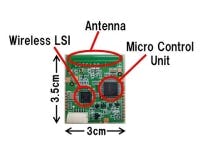Panasonic develops new multi-mode wireless technology for M2M sensor networks
Panasonic (Osaka, Japan) announced that it has developed a new wireless communication technology for machine-to-machine (M2M) sensor networks, where devices communicate with each other in an autonomous way without human intervention.
The company says the first-of-its kind technology is based on a single LSI [large-scale integration] chip that can simultaneously detect multiple wireless communication standards, which differ from one country to another or in the target applications. Multiple communication modes are integrated by sharing the software of same functions and reducing the amount of signal processing in microcomputer. As a result, engineers can design and develop wireless modules that are small but can operate for an extended period of time.
More news: Panasonic joins HDBaseT Alliance
The newly-developed technology makes it easier to connect disparate devices and helps accelerate the spread of wireless sensor networks, contributing to achieving a society with a safe, secure, convenient and comfortable living environment, adds Panasonic. The company notes that, currently, different modes of wireless communication are used in different countries and regions for connecting devices to sensor networks. The new multi-mode wireless communication technology integrates multiple receiver circuits required for each individual wireless mode into a single entity, enabling devices to be connected easily and stably to each other regardless of operation frequencies and wireless standards.
Panasonic claims that, with a smaller area, the same as the receiving part of conventional single-mode wireless chip, multi-mode wireless LSI technology can support up to three different wireless modes at a time. The new LSI helps create a small and power-saving wireless module that will continue to operate for around 20 years on one battery (when used in a smart meter or HEMS child device, and receiving/transmitting information every 30 seconds using a 1200mAh industrial-use lithium-ion battery).
Related: M2M and Internet of Things talk examines technologies' business use, benefits
Development of the technology was supported in part by the "Research and Development for Expansion of Radio Spectrum Resources" program of Japan's Ministry of Internal Affairs and Communications. Field testing of the chip commences this month at the University of Tokyo's ICT Incubation Laboratory in Research Center for Advanced Science and Technology.
Learn more about Panasonic's new wireless M2M sensor network technology.

